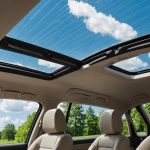Essential pre-trip checks to protect your roof antenna
Before heading out, a thorough pre-trip inspection of your roof antenna is crucial for off-road antenna safety. Start by inspecting the antenna itself for any signs of damage or looseness. Even minor cracks or wobbly mounts can worsen under rough conditions, risking complete antenna failure.
Next, secure all fittings and mounting points firmly. Tighten screws and bolts to prevent vibrations from loosening components during your off-road adventure. Loose fittings are a common cause of antenna detachment, which can lead to costly repairs.
Also read : Essential tips for sunroof maintenance: keep your car dry during rainy days
Additionally, evaluate your off-road route for potential antenna hazards. Look out for low-hanging branches, dense foliage, or tight trails where your antenna might snag or bend. Planning your route with these hazards in mind helps protect your antenna from physical damage.
By adopting these preparation tips, you enhance off-road antenna safety, reduce repair needs, and ensure uninterrupted communication during your trip. Paying attention to these essential checks before you drive off-road safeguards both your vehicle and your peace of mind.
Additional reading : Top tips for maintaining the safety and dependability of your car’s electronic parking brake
Choosing the right off-road antenna protection
Enhancing durability without compromising signal quality
Off-roading demands roof antenna protection that can withstand impacts, dirt, and harsh weather conditions. Flexible antennas are often preferred because they bend rather than break when struck by branches or obstacles. Their durability helps maintain communication integrity in rugged environments, minimizing downtime.
For those seeking convenience, removable antennas provide an excellent solution. Quick-removal antenna options allow for easy detachment before challenging trails, preventing damage during tough maneuvers. Installing these antennas usually requires minimal tools and can often be done in minutes, making them practical for frequent off-roaders.
When selecting antennas designed for rugged use, consider models specifically marketed for off-road vehicles. These often feature reinforced bases and corrosion-resistant materials. Combining roof antenna protection with flexible or removable designs maximizes lifespan and performance. Prioritize antennas that balance flexibility with stable signal transmission to ensure clear communication in remote areas.
Overall, choosing the right antenna involves weighing durability, ease of use, and signal quality for your particular off-roading needs. This approach safeguards your investment and enhances your off-road experience.
Using aftermarket guards and shields
Protecting your car’s roof antenna can be easily achieved with aftermarket antenna guards designed specifically for durability and style. These guards serve as a reliable barrier, preventing damage from environmental factors and accidental impacts. Choosing the right aftermarket antenna shields involves looking for materials like high-grade silicone, reinforced plastic, or metal composites. These materials balance flexibility and toughness, offering superior protection without compromising the antenna’s signal reception.
Designs for these guards vary, ranging from minimalist caps to full-coverage shields that wrap securely around the antenna base. Popular car roof antenna accessories often feature UV-resistant coatings to prevent fading and cracking over time, prolonging the guard’s lifespan. Additionally, many come in various finishes, like matte black or chrome, to blend seamlessly with your vehicle’s aesthetics.
Installation is typically straightforward, requiring no specialized tools or skills. Most aftermarket guards fit universally but checking compatibility with your specific antenna model ensures a snug and effective fit. Before installation, clean the antenna thoroughly to improve adhesion and reduce the risk of corrosion beneath the guard. Proper installation of aftermarket antenna shields protects investment and maintains optimal antenna performance year-round.
DIY solutions and temporary covers
Creating DIY antenna protection can be a practical and affordable way to safeguard your vehicle’s antenna during off-road adventures. Before your trip, consider crafting a homemade antenna cover using cost-effective materials like flexible rubber tubing or silicone sleeves, which are easily shaped and provide decent impact resistance. Cutting the tubing to fit snugly over the antenna shaft helps prevent scratches and minor bends.
For temporary antenna shields, sturdy plastic bottles or sections of PVC pipe work well as protective sheaths. These can be secured with zip ties or weatherproof tape, offering quick and effective coverage. Use these temporary solutions when storage space or budget limits prevent specialized covers.
Applying a DIY cover requires ensuring it doesn’t interfere with antenna functionality or vehicle operation. Always check that the cover fits tightly without slipping, enabling effective protection against debris or accidental impacts on rough terrain.
By using these cost-effective materials and strategies, you can reduce damage risks without investing in expensive products, making DIY antenna covers an excellent option for any off-road enthusiast wanting reliable, affordable protection.
Recognising and Coping with Common Off-Road Antenna Hazards
Navigating off-road terrain demands vigilance for off-road hazards that can jeopardise your vehicle’s roof antenna. Among the chief threats are low-hanging branches, which often lurk just out of immediate sight yet pose significant antenna damage risks. These branches can snag or snap antennas, leading to costly repairs or loss of signal.
Additionally, be mindful of narrow trails featuring low tunnels or dense overhead foliage. These can create tight spaces where antennas are vulnerable. Debris like fallen twigs or sharp objects on the path also elevates the risk of antenna damage.
To mitigate these risks, it’s essential to adjust your driving strategies: slow down when entering heavily wooded areas, maintain heightened awareness of overhanging obstacles, and consider retractable or shorter antennas designed for rugged environments. Positioning your vehicle to avoid antenna strikes may mean taking a wider line or temporarily halting to assess the path ahead.
If damage occurs, an immediate emergency response includes inspecting the antenna for bends or breaks and securing it to prevent further harm. Keeping a compact antenna repair kit on hand can provide quick fixes until professional servicing is possible. Prioritising antenna care ensures uninterrupted communication and a safer off-road adventure.


